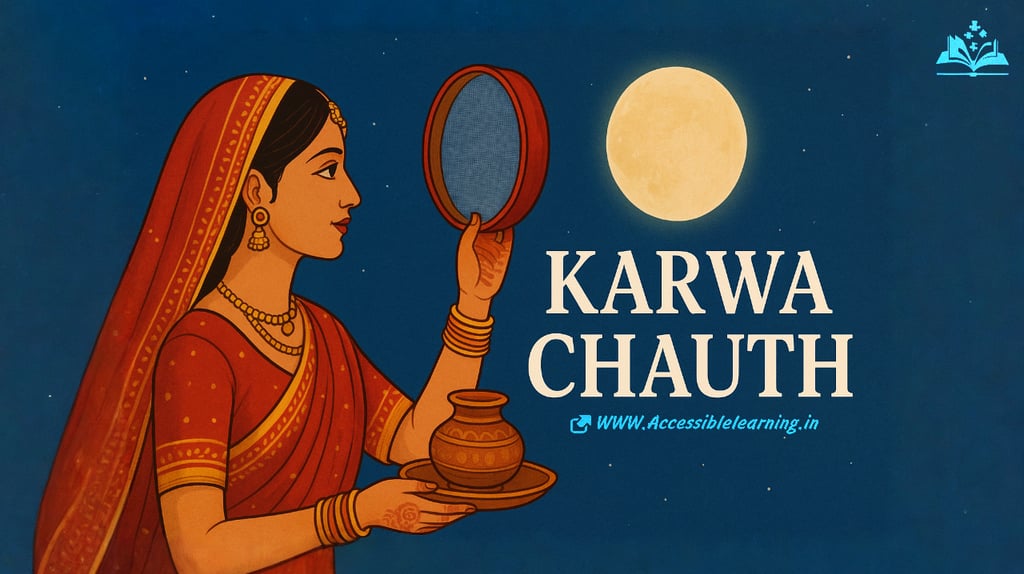
Karwa Chauth: Tradition, Significance, and Science Behind the Sacred Fast
Discover the significance of Karwa Chauth 2025—a festival of love, devotion, and tradition. Learn why it is celebrated, its scientific and cultural importance, rituals, and the deep meaning behind fasting for marital harmony and prosperity.
CULTURE/TRADITIONINDIA/BHARATCELEBRATION/FESTIVALS
Keshav Jha
10/4/20253 min read


Karwa Chauth is one of the most cherished festivals in India, especially in the northern states like Punjab, Uttar Pradesh, Haryana, Rajasthan, and Delhi. It is celebrated by married Hindu women who observe a day-long fast for the long life, prosperity, and well-being of their husbands. Beyond rituals and devotion, Karwa Chauth carries deep cultural, emotional, and even scientific relevance that makes it much more than just a festival of fasting.
What is Karwa Chauth?
Karwa Chauth falls on the fourth day after the full moon (Purnima) in the Hindu month of Kartik (October–November). On this day, married women abstain from food and water (nirjala vrat) from sunrise to moonrise. The fast is broken only after sighting the moon and performing puja rituals, where the wife sees her husband through a sieve and then drinks water from his hands.
The word “Karwa” means earthen pot (symbolizing prosperity), and “Chauth” means the fourth day. The Karwa is used during rituals and later gifted as a token of blessings and love.
Why is Karwa Chauth Celebrated?
The festival is rooted in love, loyalty, and prayers for longevity. Historically, Karwa Chauth was not only about marital devotion but also about women’s solidarity in villages and small communities:
Women gathered to pray together, exchange gifts, and build strong emotional bonds.
It was seen as a seasonal festival—right before the winter sowing period—where families prayed for a good harvest and prosperous times ahead.
In traditional Indian society, where men often went away to wars or long journeys, women observed the fast for their husbands’ safe return.
Thus, Karwa Chauth symbolizes faith, protection, and emotional connection between spouses and within the community.
Importance of Karwa Chauth in Today’s Time
Strengthens Marital Bond—The ritual of breaking the fast with the husband nurtures emotional closeness, trust, and affection.
Cultural Continuity—It keeps age-old traditions alive and connects modern families with ancestral practices.
Women’s Togetherness—The festival provides a platform for women to come together, share stories, and celebrate unity.
Emotional Well-being—Beyond religious beliefs, the rituals instill patience, mindfulness, and self-control.
The Scientific Perspective of Karwa Chauth
While Karwa Chauth is primarily cultural and religious, some scientific and health-related aspects can also be observed:
Detoxification through Fasting—A day without food and water allows the digestive system to rest, promoting natural detoxification.
Celestial Connection—The fast is closely tied with the lunar cycle. Just as the moon influences tides and water, ancient traditions believed it also influences human emotions and biological rhythms.
Strengthening Willpower—Observing nirjala vrat requires mental strength, which enhances discipline and emotional resilience.
Sun & Moon Energy—Offering water (Arghya) to the moon symbolizes balancing the body’s energy cycle with natural cosmic forces.
Circadian Rhythm Balance—Fasting until moonrise aligns the body’s energy with natural light cycles, something modern chronobiology also highlights.

Traditional Rituals of Karwa Chauth
Sargi—Before sunrise, married women eat a special pre-dawn meal (sargi), usually prepared by the mother-in-law. It includes fruits, sweets, dry fruits, and sometimes parathas.
Day-long Nirjala Fast—Women refrain from eating or drinking until moonrise.
Karwa Puja—In the evening, women dress up in traditional attire (often bridal-like), apply mehendi, and gather for puja. They narrate the Karwa Chauth Katha (story) which highlights sacrifice and devotion.
Moonrise Ritual—Women see the moon through a sieve, offer water, and then see their husband’s face, marking the end of the fast.
Breaking the Fast—The husband gives the first sip of water and food to his wife, symbolizing love, care, and partnership.
The Deeper Symbolism of Karwa Chauth
Sieve (Chhanni)—Represents filtering out negativity and focusing only on love and togetherness.
Karwa (Earthen Pot)—Symbolizes prosperity, fertility, and the cycle of life.
Moon—Stands for beauty, calmness, and eternal love.
Fasting Together—In modern times, many husbands also observe the fast, symbolizing equality and companionship.
Karwa Chauth is not just a festival of fasting but a celebration of love, devotion, community, and tradition. It reflects how culture, science, and human emotions are interwoven in Indian traditions. In today’s fast-paced world, Karwa Chauth acts as a reminder of the power of faith, patience, and the sacred bond of marriage.
FAQs
Q. Is Karwa Chauth only for married women?
Traditionally yes, but nowadays even unmarried women observe it, wishing for a good life partner.
Q. Why is water not allowed during the fast?
It’s a form of discipline and self-control, though some women modify it based on health conditions.
Q. Can men also observe Karwa Chauth?
Yes, many husbands fast along with their wives as a gesture of love and equality.
Q. What is the role of the moon in Karwa Chauth?
The moon symbolizes eternal love and calmness, and rituals align with lunar cycles believed to affect human emotions.
Q. Does Karwa Chauth have health benefits?
Yes, fasting supports detoxification, boosts discipline, and strengthens emotional resilience.
Subscribe to our newsletter
All © Copyright reserved by Accessible-Learning
| Terms & Conditions
Knowledge is power. Learn with Us. 📚


